- Joined
- Feb 2, 2011
- Messages
- 2,093
NEW RELEASES FOR JULY 2024
THE AMERICAN CIVIL WAR
THE BATTLE OF BRANDY STATION, JUNE 9[SUP]th[/SUP], 1863
THE ARMY OF THE POTOMAC, CAVALRY CORPS.
UNION CAVALRY
The Battle Of Brandy Station, also called the Battle of Fleetwood Hill, was the largest predominantly cavalry engagement of the American Civil War, as well as the largest ever to take place on American soil. It was fought on June 9[SUP]th[/SUP], 1863, around Brandy Station, Virginia at the beginning of the Gettysburg Campaign by the Union cavalry under Maj.Gen. Alfred Pleasonton against Maj. Gen. J.E.B. Stuart’s Confederate cavalry.
After an all day fight in which fortunes changed repeatedly, the Federals retired without discovering Gen. Robert E. Lee’s infantry camped near Culpeper. This battle marked the end of the Confederate cavalry’s dominance in the East.
From this point in the war the Federal cavalry gained strength and confidence.
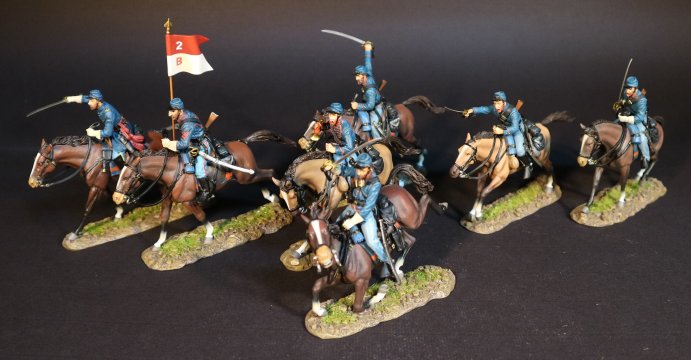
The Battle saw nine thousand Union cavalrymen and three thousand Union infantry clash with ten thousand Confederate horsemen. The fighting lasted for roughly twelve hours and covered dozens of square miles.
Unknown to the Confederates, 12,000 Union men had massed on the other side of the Rappahannock River.
Maj. Gen. Alfred Pleasonton, commanding the Cavalry Corps of the Army of The Potomac, had organized his combined armed forces into two wings, under Brig. Gen. John Buford and David McMurtrie Gregg, augmented by infantry brigades from the V Corps.
Buford’s wing, accompanied by Pleasonton, consisted of his own 1[SUP]st[/SUP] Cavalry Division, a reserve brigade led by Maj. Charles J. Whiting, and an infantry brigade of 3,000 men under Brig. Gen. Adelbert Ames.
Gregg’s wing was the 2[SUP]nd[/SUP] Cavalry Division, led by Col. Alfred N. Duffie, the 3[SUP]rd[/SUP] Cavalry Division led by Gregg, and an infantry brigade under Brig. Gen. David A. Russell.
The commander of the Army of the Potomac, Maj. Gen. Joseph Hooker, interpreted the enemy’s cavalry presence around Culpeper to be indicative of preparations for a raid of his army’s supply lines. In reaction to this, he ordered Pleasonton’s force on a “spoiling raid”, to “disperse and destroy” the Confederates.
Pleasonton’s attack plan called for a two-pronged thrust at the enemy. Buford’s wing would cross the river at Beverly’s Ford, two miles northeast of Brandy Station, at the same time, Gregg would cross at Kelly’s Ford, six miles downstream to the southeast.
Pleasonton anticipated that the Southern cavalry would be caught in a double envelopment, surprised, outnumbered, and beaten.
He was, however, unaware of the precise disposition of the enemy and he incorrectly assumed that his force was substantially larger than the Confederates he faced.
Both sides at Brandy Station were armed in a similar manner. For mounted combat, cavalrymen carried light cavalry sabers and pistols. Some Confederate cavalry carried more than one pistol, or a shotgun, and basically used what they could get a hold of.
In a melee or skirmish, there was no intrinsic superiority of pistol over a saber. Even an excellent shot found hitting a moving mounted enemy target difficult, and sabers had the advantage they did not need to be reloaded. The saber had the advantage of intimidation during a charge, with many defenders breaking when faced by a crowd of riders waving sabers, even before the charging troops reached them.
A typical cavalry charge against cavalry was a relatively rare occurrence, usually with one side or the other breaking and bolting before contact. If hand to hand combat ensued, the fighting was confusing, vicious and protracted. If one side committed reserve squadrons to the fray, they often carried the day.
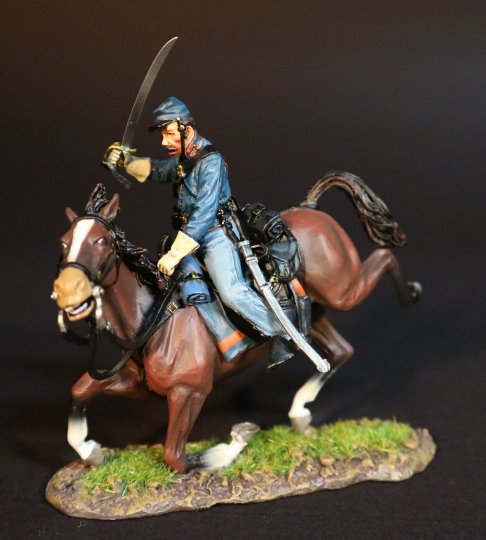
USBS2-10
THE AMERICAN CIVIL WAR 1861 - 1865
THE BATTLE OF BRANDY STATION, JUNE 9[SUP]th[/SUP], 1863,
THE ARMY OF THE POTOMAC,
CAVALRY CORPS,
2[SUP]nd[/SUP] US CAVALRY REGIMENT
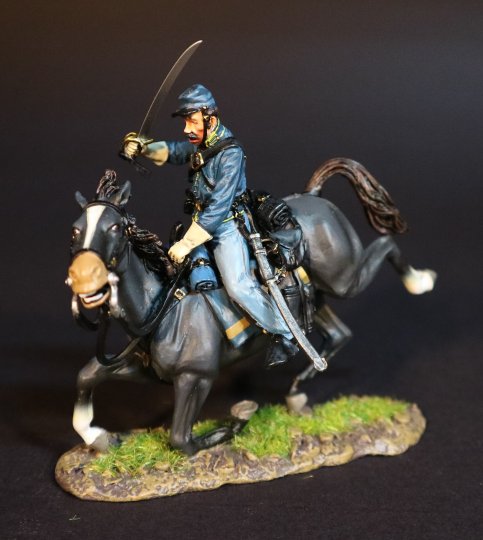
USBS-10
THE AMERICAN CIVIL WAR 1861 - 1865
THE BATTLE OF BRANDY STATION, JUNE 9[SUP]th[/SUP], 1863,
THE ARMY OF THE POTOMAC,
CAVALRY CORPS
UNION CAVALRY
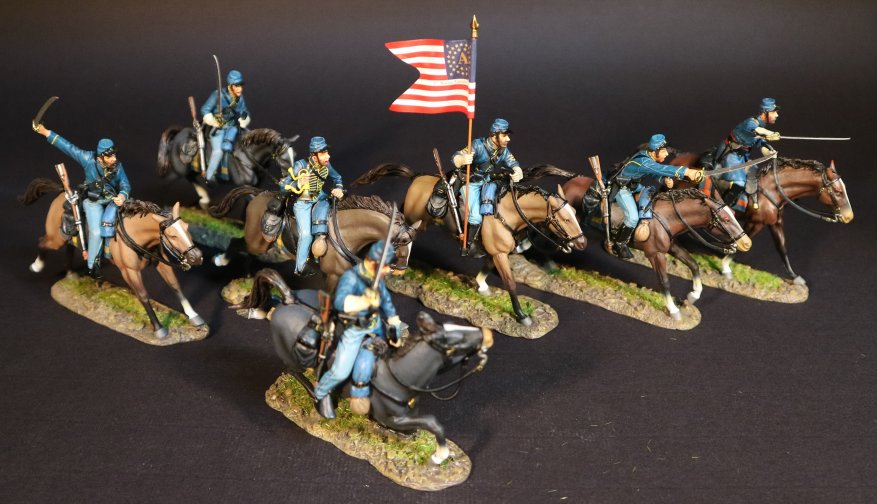
THE BATTLE OF BRANDY STATION, JUNE 9[SUP]th[/SUP], 1863
THE ARMY OF NORTHERN VIRGINIA, CAVALRY DIVISION,
CONFEDERATE CAVALRY
The Battle of Brandy Station saw nine thousand Union cavalrymen and three thousand Union infantry clash with ten thousand Confederate horsemen. The fighting lasted for roughly twelve hours and covered dozens of square miles.
Unknown to the Confederates, 12,000 Union men had massed on the other side of the Rappahannock River.
Maj. Gen. Alfred Pleasonton, commanding the Cavalry Corps of the Army of The Potomac, had organized his combined armed forces into two wings, under Brig. Gen. John Buford and David McMurtrie Gregg, augmented by infantry brigades from the V Corps.
Buford’s wing, accompanied by Pleasonton, consisted of his own 1[SUP]st[/SUP] Cavalry Division, a reserve brigade led by Maj. Charles J. Whiting, and an infantry brigade of 3,000 men under Brig. Gen. Adelbert Ames.
Gregg’s wing was the 2[SUP]nd[/SUP] Cavalry Division, led by Col. Alfred N. Duffie, the 3[SUP]rd[/SUP] Cavalry Division led by Gregg, and an infantry brigade under Brig. Gen. David A. Russell.
The commander of the Army of the Potomac, Maj. Gen. Joseph Hooker, interpreted the enemy’s cavalry presence around Culpeper to be indicative of preparations for a raid of his army’s supply lines. In reaction to this, he ordered Pleasonton’s force on a “spoiling raid”, to “disperse and destroy” the Confederates.
Pleasonton’s attack plan called for a two-pronged thrust at the enemy. Buford’s wing would cross the river at Beverly’s Ford, two miles northeast of Brandy Station, at the same time, Gregg would cross at Kelly’s Ford, six miles downstream to the southeast.
Pleasonton anticipated that the Southern cavalry would be caught in a double envelopment, surprised, outnumbered, and beaten.
He was, however, unaware of the precise disposition of the enemy and he incorrectly assumed that his force was substantially larger than the Confederates he faced.
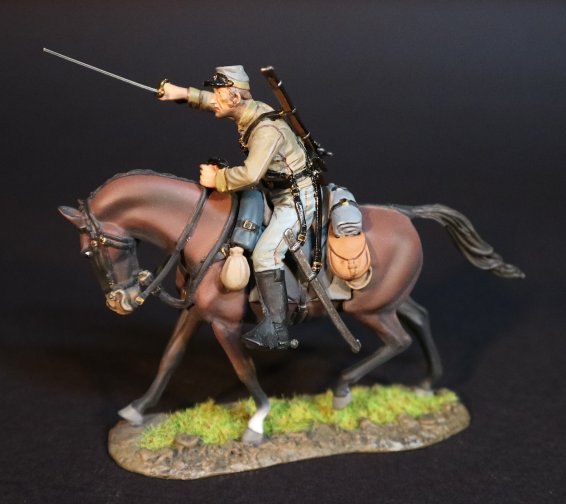
CSBS-09A
THE AMERICAN CIVIL WAR 1861 - 1865
THE BATTLE OF BRANDY STATION, JUNE 9[SUP]th[/SUP], 1863,
THE ARMY OF NORTHERN VIRGINIA, CAVALRY DIVISION,
CONFEDERATE CAVALRYMAN
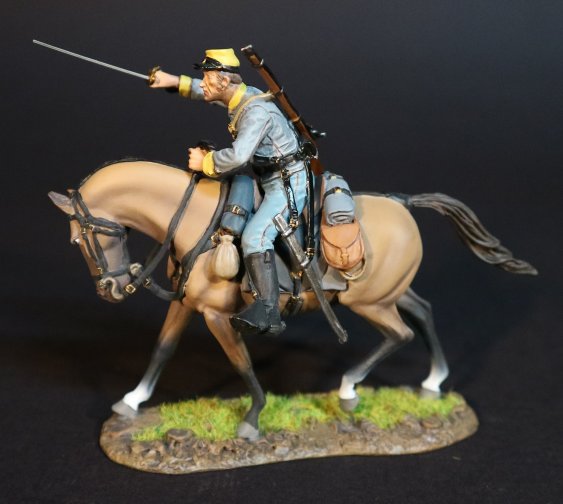
CSBS-09B
THE AMERICAN CIVIL WAR 1861 - 1865
THE BATTLE OF BRANDY STATION, JUNE 9[SUP]th[/SUP], 1863,
THE ARMY OF NORTHERN VIRGINIA, CAVALRY DIVISION,
CONFEDERATE CAVALRYMAN
THE AMERICAN CIVIL WAR
ARTILLERY
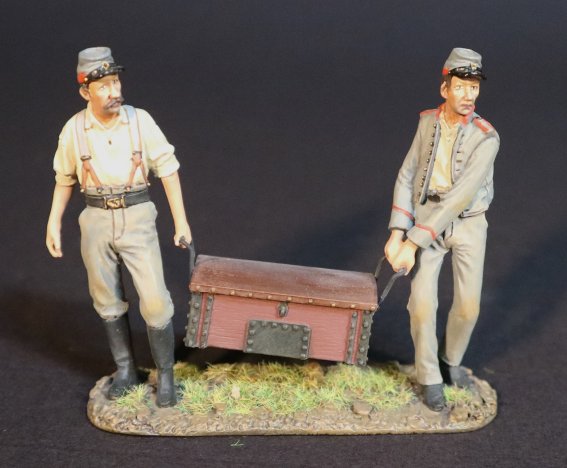
ROCKART-12
THE AMERICAN CIVIL WAR 1861 - 1865
THE FIRST BATTLE OF MANASSAS, 1861.
THE ARMY OF THE SHENANDOAH,
1[SUP]st[/SUP] ROCKBRIDGE ARTILLERY
ARTILLERY CREW
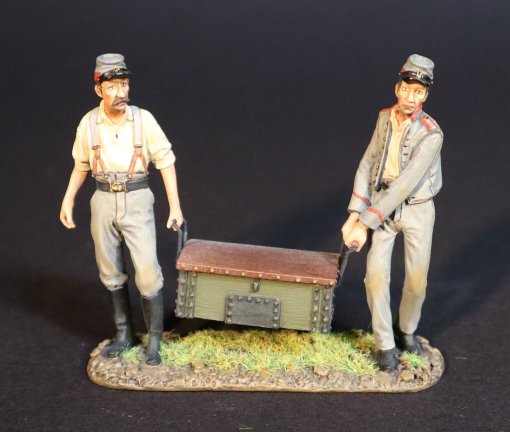
CSART-17
THE AMERICAN CIVIL WAR 1861 - 1865
CONFEDERATE ARTILLERY,
ARTILLERY CREW
THE 3[SUP]rd[/SUP] NEW JERSEY CAVALRY REGIMENT 1864.
“THE BUTTERFLIES”

Towards the war’s end most of the Federal cavalry were equipped and supplied via centralized depots, one of the units which stood out as belonging to another time and place was the 3[SUP]rd[/SUP] New Jersey Cavalry, or the “Butterflies”, a nickname they were given for their flamboyant attire.
Raised initially in January 1864 as the 1[SUP]st[/SUP] U.S. Hussars, they were dressed in such splendour previously unseen in other Federal cavalry regiments, which was deliberate in an attempt to attract new recruits.
Yet their appearance was deceptive, as they were the embodiment of what the Union cavalryman had become by 1865. They were heavily armed with repeating Spencer carbines and .44 Remington revolvers which gave them the edge in skirmishes and melees with rebel cavalry and infantry units.
The state paid for the additions to the regulation cavalry uniform, the cap was the issue forage cap with the peak removed, extra braid was placed on the jacket and the remainder was US army regulation.
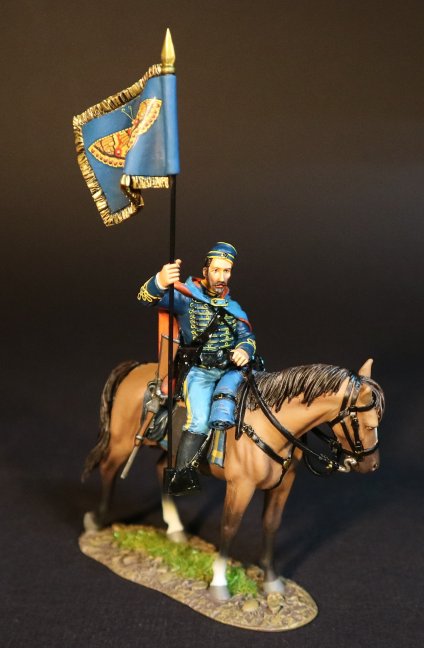
US3NJ-01
THE AMERICAN CIVIL WAR 1861 - 1865
UNION ARMY OF THE POTOMAC,
3[SUP]rd[/SUP] NEW JERSEY CAVALRY REGIMENT, 1864,
“THE BUTTERFLIES”,
STANDARD BEARER
This unit was typical of the new horse soldier which served under General Sheridan, they no longer merely served as a screen for advancing infantry. They possessed tremendous fire power and had the ability to hit the enemy hard and fast. They had eveloved into a powerful force capable of independent action.
The 3[SUP]rd[/SUP] New Jersey would serve with distinction until the war’s end routing southern cavalry at Tom’s Brook, Virginia, and seeing action at the Battle of Five Forks, which helped force Lee’s battered army out of its fortifications around Petersburg.
** PLEASE CONTACT YOUR LOCAL DEALER FOR FURTHER INFORMATION **
THE AMERICAN CIVIL WAR
THE BATTLE OF BRANDY STATION, JUNE 9[SUP]th[/SUP], 1863
THE ARMY OF THE POTOMAC, CAVALRY CORPS.
UNION CAVALRY
The Battle Of Brandy Station, also called the Battle of Fleetwood Hill, was the largest predominantly cavalry engagement of the American Civil War, as well as the largest ever to take place on American soil. It was fought on June 9[SUP]th[/SUP], 1863, around Brandy Station, Virginia at the beginning of the Gettysburg Campaign by the Union cavalry under Maj.Gen. Alfred Pleasonton against Maj. Gen. J.E.B. Stuart’s Confederate cavalry.
After an all day fight in which fortunes changed repeatedly, the Federals retired without discovering Gen. Robert E. Lee’s infantry camped near Culpeper. This battle marked the end of the Confederate cavalry’s dominance in the East.
From this point in the war the Federal cavalry gained strength and confidence.

The Battle saw nine thousand Union cavalrymen and three thousand Union infantry clash with ten thousand Confederate horsemen. The fighting lasted for roughly twelve hours and covered dozens of square miles.
Unknown to the Confederates, 12,000 Union men had massed on the other side of the Rappahannock River.
Maj. Gen. Alfred Pleasonton, commanding the Cavalry Corps of the Army of The Potomac, had organized his combined armed forces into two wings, under Brig. Gen. John Buford and David McMurtrie Gregg, augmented by infantry brigades from the V Corps.
Buford’s wing, accompanied by Pleasonton, consisted of his own 1[SUP]st[/SUP] Cavalry Division, a reserve brigade led by Maj. Charles J. Whiting, and an infantry brigade of 3,000 men under Brig. Gen. Adelbert Ames.
Gregg’s wing was the 2[SUP]nd[/SUP] Cavalry Division, led by Col. Alfred N. Duffie, the 3[SUP]rd[/SUP] Cavalry Division led by Gregg, and an infantry brigade under Brig. Gen. David A. Russell.
The commander of the Army of the Potomac, Maj. Gen. Joseph Hooker, interpreted the enemy’s cavalry presence around Culpeper to be indicative of preparations for a raid of his army’s supply lines. In reaction to this, he ordered Pleasonton’s force on a “spoiling raid”, to “disperse and destroy” the Confederates.
Pleasonton’s attack plan called for a two-pronged thrust at the enemy. Buford’s wing would cross the river at Beverly’s Ford, two miles northeast of Brandy Station, at the same time, Gregg would cross at Kelly’s Ford, six miles downstream to the southeast.
Pleasonton anticipated that the Southern cavalry would be caught in a double envelopment, surprised, outnumbered, and beaten.
He was, however, unaware of the precise disposition of the enemy and he incorrectly assumed that his force was substantially larger than the Confederates he faced.
Both sides at Brandy Station were armed in a similar manner. For mounted combat, cavalrymen carried light cavalry sabers and pistols. Some Confederate cavalry carried more than one pistol, or a shotgun, and basically used what they could get a hold of.
In a melee or skirmish, there was no intrinsic superiority of pistol over a saber. Even an excellent shot found hitting a moving mounted enemy target difficult, and sabers had the advantage they did not need to be reloaded. The saber had the advantage of intimidation during a charge, with many defenders breaking when faced by a crowd of riders waving sabers, even before the charging troops reached them.
A typical cavalry charge against cavalry was a relatively rare occurrence, usually with one side or the other breaking and bolting before contact. If hand to hand combat ensued, the fighting was confusing, vicious and protracted. If one side committed reserve squadrons to the fray, they often carried the day.

USBS2-10
THE AMERICAN CIVIL WAR 1861 - 1865
THE BATTLE OF BRANDY STATION, JUNE 9[SUP]th[/SUP], 1863,
THE ARMY OF THE POTOMAC,
CAVALRY CORPS,
2[SUP]nd[/SUP] US CAVALRY REGIMENT

USBS-10
THE AMERICAN CIVIL WAR 1861 - 1865
THE BATTLE OF BRANDY STATION, JUNE 9[SUP]th[/SUP], 1863,
THE ARMY OF THE POTOMAC,
CAVALRY CORPS
UNION CAVALRY

THE BATTLE OF BRANDY STATION, JUNE 9[SUP]th[/SUP], 1863
THE ARMY OF NORTHERN VIRGINIA, CAVALRY DIVISION,
CONFEDERATE CAVALRY
The Battle of Brandy Station saw nine thousand Union cavalrymen and three thousand Union infantry clash with ten thousand Confederate horsemen. The fighting lasted for roughly twelve hours and covered dozens of square miles.
Unknown to the Confederates, 12,000 Union men had massed on the other side of the Rappahannock River.
Maj. Gen. Alfred Pleasonton, commanding the Cavalry Corps of the Army of The Potomac, had organized his combined armed forces into two wings, under Brig. Gen. John Buford and David McMurtrie Gregg, augmented by infantry brigades from the V Corps.
Buford’s wing, accompanied by Pleasonton, consisted of his own 1[SUP]st[/SUP] Cavalry Division, a reserve brigade led by Maj. Charles J. Whiting, and an infantry brigade of 3,000 men under Brig. Gen. Adelbert Ames.
Gregg’s wing was the 2[SUP]nd[/SUP] Cavalry Division, led by Col. Alfred N. Duffie, the 3[SUP]rd[/SUP] Cavalry Division led by Gregg, and an infantry brigade under Brig. Gen. David A. Russell.
The commander of the Army of the Potomac, Maj. Gen. Joseph Hooker, interpreted the enemy’s cavalry presence around Culpeper to be indicative of preparations for a raid of his army’s supply lines. In reaction to this, he ordered Pleasonton’s force on a “spoiling raid”, to “disperse and destroy” the Confederates.
Pleasonton’s attack plan called for a two-pronged thrust at the enemy. Buford’s wing would cross the river at Beverly’s Ford, two miles northeast of Brandy Station, at the same time, Gregg would cross at Kelly’s Ford, six miles downstream to the southeast.
Pleasonton anticipated that the Southern cavalry would be caught in a double envelopment, surprised, outnumbered, and beaten.
He was, however, unaware of the precise disposition of the enemy and he incorrectly assumed that his force was substantially larger than the Confederates he faced.

CSBS-09A
THE AMERICAN CIVIL WAR 1861 - 1865
THE BATTLE OF BRANDY STATION, JUNE 9[SUP]th[/SUP], 1863,
THE ARMY OF NORTHERN VIRGINIA, CAVALRY DIVISION,
CONFEDERATE CAVALRYMAN

CSBS-09B
THE AMERICAN CIVIL WAR 1861 - 1865
THE BATTLE OF BRANDY STATION, JUNE 9[SUP]th[/SUP], 1863,
THE ARMY OF NORTHERN VIRGINIA, CAVALRY DIVISION,
CONFEDERATE CAVALRYMAN
THE AMERICAN CIVIL WAR
ARTILLERY

ROCKART-12
THE AMERICAN CIVIL WAR 1861 - 1865
THE FIRST BATTLE OF MANASSAS, 1861.
THE ARMY OF THE SHENANDOAH,
1[SUP]st[/SUP] ROCKBRIDGE ARTILLERY
ARTILLERY CREW

CSART-17
THE AMERICAN CIVIL WAR 1861 - 1865
CONFEDERATE ARTILLERY,
ARTILLERY CREW
THE 3[SUP]rd[/SUP] NEW JERSEY CAVALRY REGIMENT 1864.
“THE BUTTERFLIES”

Towards the war’s end most of the Federal cavalry were equipped and supplied via centralized depots, one of the units which stood out as belonging to another time and place was the 3[SUP]rd[/SUP] New Jersey Cavalry, or the “Butterflies”, a nickname they were given for their flamboyant attire.
Raised initially in January 1864 as the 1[SUP]st[/SUP] U.S. Hussars, they were dressed in such splendour previously unseen in other Federal cavalry regiments, which was deliberate in an attempt to attract new recruits.
Yet their appearance was deceptive, as they were the embodiment of what the Union cavalryman had become by 1865. They were heavily armed with repeating Spencer carbines and .44 Remington revolvers which gave them the edge in skirmishes and melees with rebel cavalry and infantry units.
The state paid for the additions to the regulation cavalry uniform, the cap was the issue forage cap with the peak removed, extra braid was placed on the jacket and the remainder was US army regulation.

US3NJ-01
THE AMERICAN CIVIL WAR 1861 - 1865
UNION ARMY OF THE POTOMAC,
3[SUP]rd[/SUP] NEW JERSEY CAVALRY REGIMENT, 1864,
“THE BUTTERFLIES”,
STANDARD BEARER
This unit was typical of the new horse soldier which served under General Sheridan, they no longer merely served as a screen for advancing infantry. They possessed tremendous fire power and had the ability to hit the enemy hard and fast. They had eveloved into a powerful force capable of independent action.
The 3[SUP]rd[/SUP] New Jersey would serve with distinction until the war’s end routing southern cavalry at Tom’s Brook, Virginia, and seeing action at the Battle of Five Forks, which helped force Lee’s battered army out of its fortifications around Petersburg.
** PLEASE CONTACT YOUR LOCAL DEALER FOR FURTHER INFORMATION **

